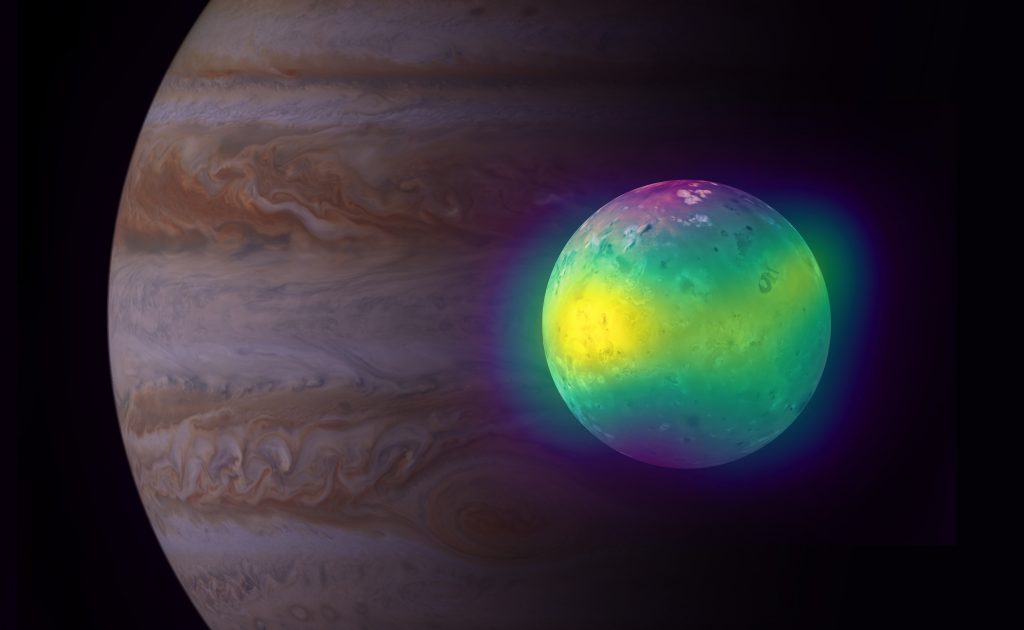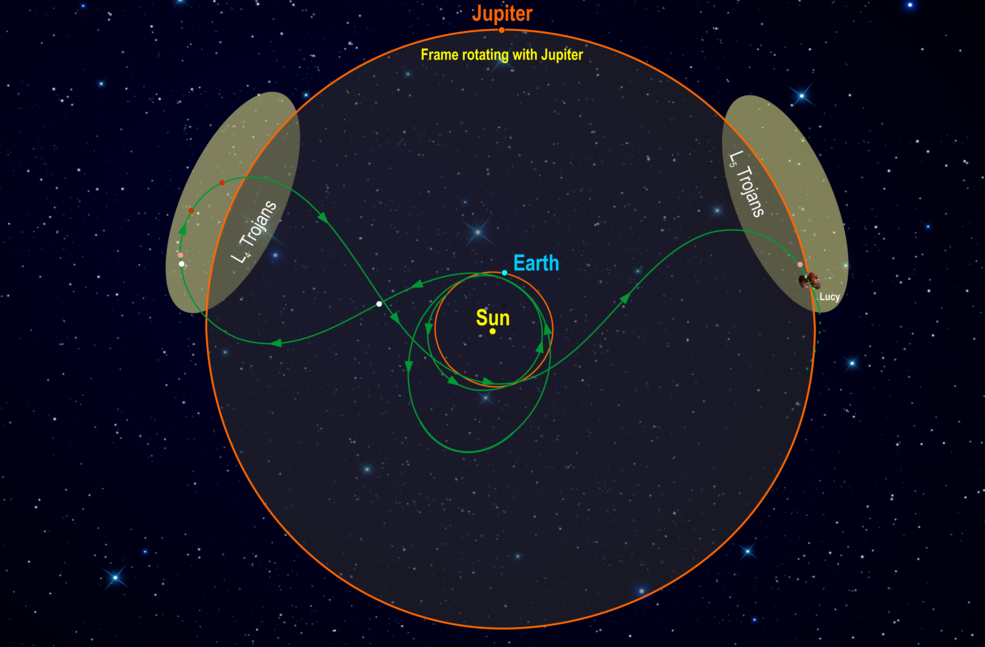Media
Transcript
Those of you who know me know that I have a favorite small body in our solar system: Jupiter’s moon Io. It is covered in volcanoes. Its surface is constantly being re-covered by lava. And plate tectonics is not the reason.
Jupiter heats up its moon by pulling on Io gravitationally, the same way the Sun pulls on the Earth, making our home planet more of an oblate spheroid than a perfect sphere. However, Jupiter has some help in the process: 1) Io is tidally locked, so the same side always faces Jupiter, and 2) the outer Galilean moons – particularly Europa and Ganymede – pull on Io in the opposite direction, and they do it regularly because of resonant orbits.

Orbital resonance occurs when two or more bodies orbit a larger body at cycles that regularly overlap. In this case, for every one time Io orbits Jupiter, Europa orbits twice and Ganymede orbits four times. All the time. Every time. So there is a regular back and forth gravitational pull between the outer moons and Jupiter, and this pulling causes Io to expand and contract. That expansion/contraction cycle causes friction, and friction causes tidal heating.
All that heat allows Io to have a layer of liquid magma, and all the expansion and contraction make lots of easy places for volcanic eruptions. And voila, the most geologically active body in our solar system is a moon!
Of course, with volcanoes comes sulfur dioxide gas, and the condensate of that gas is what makes Io’s surface so very yellow and orange and, frankly, looking like pizza. Keeping all this bright condensate on the surface is Io’s thin atmosphere, which is, as expected, full of sulfuric gas. And scientists have wondered how much of that gas came directly from the volcanoes and how much came from sublimation due to sunlight.
All of which leads me to today’s first news story. (Did I mention I love Io?) In a new paper, published in The Planetary Science Journal with lead author Imke de Pater, researchers used the Atacama Large Millimeter/submillimeter Array (ALMA) in Chile to take pictures of Io while it was both eclipsed by Jupiter from the Sun and when it was back in direct sunlight. As Statia Luszcz-Cook explained: When Io passes into Jupiter’s shadow, and is out of direct sunlight, it is too cold for sulfur dioxide gas, and it condenses onto Io’s surface. During that time we can only see volcanically-sourced sulfur dioxide. We can therefore see exactly how much of the atmosphere is impacted by volcanic activity.
Based on the images, which can be seen in a video on Daily Space, the team calculated that the active volcanoes directly produce 30-50 percent of Io’s atmosphere. That’s a lot. All this science leads up to solving what makes the tidal heating process tick, so to speak. As Luszcz-Cook said: By studying Io’s atmosphere and volcanic activity we learn more about not only the volcanoes themselves, but also the tidal heating process and Io’s interior.
Next up, the team hopes to use ALMA to get even more images of Io’s surface in an attempt to measure the temperature of the moon’s lower atmosphere. When that work is done and published, you know I will bring the story to you.
I don’t have any other big stories to bring to you today. Aside from Io, the planetary science news cycle was heavily dominated by OSIRIS-REx and the touch-and-go sample performed earlier this week. Everyone has been talking about the mission, and with all our personal involvement in the science (so many rocks), CosmoQuest has done more than its fair share of covering Bennu.

So what’s next? Well, we are definitely going to wait for the moment of inertia measurement OSIRIS-REx will perform as it determines just how much sample it picked up. That will determine whether or not the team has to collect more material from another sampling site. Once all that is sorted out, we have to wait until early next year for the spacecraft to head for home. And after that, we have the long wait until September 2023 for the physical sample return.
All that time doesn’t even take into account performing actual science on the sample by all the agencies that get a piece of it!
In the meantime, and I know Dr. Pamela is rolling her eyes as she hears me say these words, there are three more asteroid missions to look forward to. The Double Asteroid Redirection Test (DART) and Lucy missions will launch in July and October 2021, respectively, and the Psyche mission has a 2022 launch date.

DART is a first of its kind mission to test out a possible planetary defense option. I don’t mean something to keep the aliens at bay. Sorry, Space Force. I’m talking about keeping the asteroids at bay. We’ve had a lot of close flybys so far this year, and I’ve gotten to report on most of them. DART would make those flybys possibly less scary.
As NASA says, “DART will be the first demonstration of the kinetic impactor technique to change the motion of an asteroid in space. The target is the Didymos binary asteroid system consisting of the larger Didymos and its smaller ‘moonlet’ Dimorphos, with diameters of ~780 and 160 m, respectively. The spacecraft will hit Dimorphos with an almost head-on impact in September 2022 that will change the speed and path of Dimorphos.”
Don’t worry. There is no potential for causing either of these bodies to threaten Earth.
A whole bunch of agencies are participating in this mission, both to take images of the potential ejecta from the impact with a CubeSat and to measure any change in the orbit of the moonlet using ground-based telescopes. Johns Hopkins University Applied Physics Laboratory leads the mission for NASA.

After DART comes Lucy. We’ve talked about Lucy on the Daily Space before. Here’s a quick refresher from NASA: “Lucy will take a 12-year journey to survey the diversity of one main-belt asteroid and seven Trojan asteroids—asteroids ensnared in Jupiter’s orbit—believed to be remnants of the same material that formed the outer planets. The instrument suite aboard Lucy will characterize surface geology, surface color and composition, interior and bulk properties, in addition to satellites and rings of each asteroid.”
The mission is led by the Southwest Research Institute and seeks to give us insight into planetary formation processes. I would not be surprised if the results upend some way of thinking about our solar system and how it formed. That seems to happen regularly now.

Last but definitely not least is the Psyche mission. Asteroid Psyche 16 is a metal asteroid that scientists think could be the “unreachable” core of a formerly large terrestrial body similar to Earth. Per NASA: The mission’s instruments will not only characterize topography but will help scientists determine if Psyche 16 is truly a proto-planet’s core or if it is unmolten material. They will also be able to conclude relative ages of regions of the asteroid’s surface and determine if small metal bodies contain similar light elements expected in the high-pressure cores of terrestrial planets.
Personally, I’m intrigued by the idea that Psyche was the center of another planet that broke up where the asteroid belt is. Growing up, I always wondered if the asteroid belt was the remains of a planet that Jupiter pulled apart. While that concept is mostly science fiction with Jupiter likely not having allowed anything in that region to coalesce into a planet in the first place, perhaps Psyche will change the theory once again.
From our solar system back out to exoplanets, this last story caught my attention. It’s one of those delightfully hypothetical thought experiments with some geometry thrown in.
A pair of scientists published a paper in the Monthly Notices of the Royal Astronomical Society this week that asks the question “which stars can see Earth as a transiting exoplanet?” Using data from NASA’s Transiting Exoplanet Survey Satellite (TESS) star catalog and per the press release, they “identified 1,004 main-sequence stars (similar to our sun) that might contain Earth-like planets in their own habitable zones – all within about 300 light-years of Earth – and which should be able to detect Earth’s chemical traces of life.”

Lead author Lisa Kaltenegger goes on to explain: If observers were out there searching, they would be able to see signs of a biosphere in the atmosphere of our Pale Blue Dot. And we can even see some of the brightest of these stars in our night sky without binoculars or telescopes.
Here’s where the geometry comes in: Earth’s ecliptic plane, or the plane in which we orbit the Sun, has to line up just right for those exoplanets to see our planet transit our star. It’s one of the main ways we find exoplanets ourselves, so it makes sense that a technologically advanced civilization would do the same.
Co-author Joshua Pepper noted: Only a very small fraction of exoplanets will just happen to be randomly aligned with our line of sight so we can see them transit. But all of the thousand stars we identified in our paper in the solar neighborhood could see our Earth transit the sun, calling their attention.
So perhaps while we are looking for a vibrant biosphere across the stars, someone out there is looking back. It gives us another good place to focus a search for bio- and technosignatures, and you all know I am for that.
In the meantime, look up and give a wave to any potential friends that might be looking back at us.
Learn More
ALMA Shows Volcanic Impact on Io’s Atmosphere
- ALMA press release
- UC Berkeley press release
- “ALMA Observations of Io Going Into and Coming Out of Eclipse,” Imke de Pater, Statia Luszcz-Cook et al., 2020 Oct. 21, Planetary Science Journal (preprint on arxiv.org)
- “High Spatial and Spectral Resolution Observations of the Forbidden 1.707-Micron Rovibronic SO Emissions on Io: Evidence for Widespread Stealth Volcanism,” Imke de Pater et al., 2020 July 20, Planetary Science Journal
NASA’s Big Plans to Explore Small Bodies
Smile, Wave: Some Exoplanets May Be Able to See Us, Too
- Cornell University press release
- “Which Stars Can See Earth as a Transiting Exoplanet?” Lisa Kaltenegger &
Joshua Pepper, 2020, to appear in Monthly Notices of the Royal Astronomical
Society (preprint on arxiv.org)
Credits
Written by Beth Johnson
Hosted by Beth Johnson
Audio and Video Editing by Ally Pelphrey
Content Editing by Beth Johnson
Executive Producer Pamela Gay
Intro and Outro music by Kevin MacLeod, https://incompetech.com/music/


 We record most shows live, on Twitch. Follow us today to get alerts when we go live.
We record most shows live, on Twitch. Follow us today to get alerts when we go live.